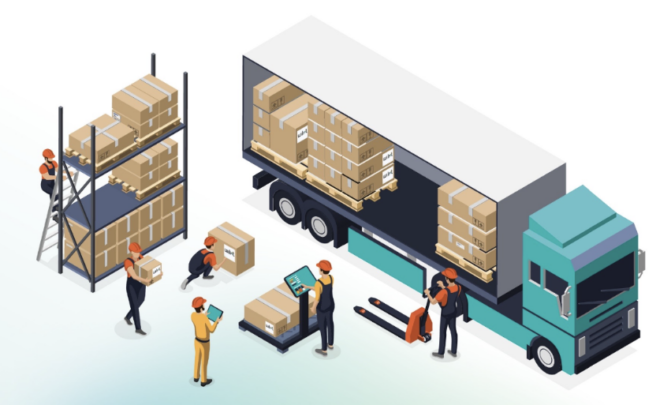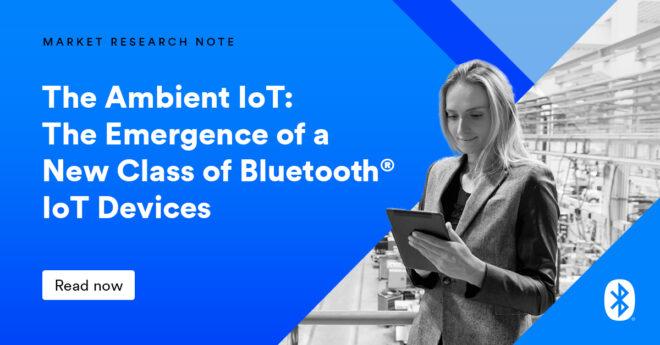The Ambient IoT is the next stage of evolution for IoT devices. It is a new class of connected devices primarily powered by harvesting energy from a viable ambient source. These ambient energy sources include radio waves, light, motion, and heat, among others. The Ambient IoT contributes to the innovation of form factor designs and low-maintenance or maintenance-free devices. The market potential is extensive, and Bluetooth LE will play a central role in the evolution of the Ambient IoT.
![]()
Understanding the Ambient IoT
The Ambient IoT is an extension of the existing IoT. Ambient IoT devices carry out many of the functions and target many of the same use cases but require additional design choices to meet solution demands. By relying on energy harvested from ambient sources, the Ambient IoT makes it possible to develop lower-cost, smaller, and maintenance-free devices, allowing the IoT to become more scalable in existing use cases and use cases still to be developed.
For instance, original equipment manufacturers (OEMs), depending on the use case and environment, may choose to make self-sustaining devices, assisted by batteries or capacitors, by powering them with ambient energy. Alternatively, OEMs may go a step further and create battery-free devices with more flexible form factors and a lower bill-of-materials (BOM) cost.
Harvesting energy from ambient sources generates only minimal amounts of power. This creates the inherent requirement for Ambient IoT devices to be less complex and more power efficient. This can be addressed by optimizing the radio protocol and adding features, such as embedded intelligence, to make devices wake up and collect or transmit data less frequently.
The advanced ecosystem Bluetooth® technology nurtured over the last 25 years, combined with Bluetooth Low Energy (LE) features, supports ongoing development and creates a broad developer base for low-power IoT solutions. Bluetooth technology allows solution providers and adopters to focus on innovation, such as form-factor designs, data management, and use cases targeting specific pain points rather than developing an entire technology stack from scratch. By further supporting the development of the Ambient IoT, Bluetooth technology will bring existing features and ecosystem advantages to a new class of IoT devices, providing long-term support and reliability to solution providers and technology adopters.
Ambient IoT Applications Enabled By Bluetooth Technology
Use cases for the Ambient IoT can be applied to any existing or new IoT application or vertical market. However, we anticipate seeing solutions for Bluetooth Electronic Shelf Labels, Bluetooth Networked Lighting Control, and Bluetooth Asset Tracking being among the first use cases to fully support the Ambient IoT.
“RTLSs and asset tracking represent the largest opportunity for Bluetooth® technology in the industrial and supply chain areas.”
– Andrew Zignani, ABI Research
Bluetooth® Industrial Applications: Sensor-based monitoring of machine status, device status, environmental conditions, or electronic labeling will be a frequent application in the industry, and a range of solutions have already been developed. For example, EnOcean intelligent switches use kinetic energy to send a signal to a control unit. Kontakt.io and Paragon ID provide battery-free tags for RTLS (real-time location system) applications. Wiliot has innovated the form factor and cost of smart labels to make them suitable for a variety of use cases, such as product monitoring and inventory management. Everactive enables condition-based monitoring for rotating equipment and steam traps by harnessing energy from multiple environmental sources.
Bluetooth® Asset Tracking: Powering rapid growth in real-time locating system (RTLS), Bluetooth technology is being used to help locate tools and workers in a warehouse or medical devices and patients in a hospital. It is also widely used for asset tracking in agriculture, food, and pharmaceuticals.
“ABI Research’s forecasts indicate that RTLSs and asset tracking represent the largest opportunity for Bluetooth® technology in the industrial and supply chain areas,” said Andrew Zignani, senior research director at ABI Research. “With low-cost and highly accurate Bluetooth LE tags becoming widely available, our analysts expect 322 million annual RTLS-based Bluetooth tag shipments by 2028. The increased adoption of Bluetooth tags for RTLS and asset tracking can be tied to the need for enterprises to prevent asset loss, comply with traceability regulations, improve staff/visitor safety, and increase productivity.”
![]()
NEW MARKET RESEARCH
The Ambient IoT – The Emergence of a New Class of Bluetooth® IoT Devices
This report defines the Ambient IoT, outlines targeted use cases, and highlights the next steps needed to capitalize on the Ambient IoT opportunity. It also explains the central role of Bluetooth® technology in addressing Ambient IoT use cases, characterized by its low power consumption, low cost, flexibility, interoperability, and scalability.
Bluetooth® Electronic Shelf Labels (ESL): ESLs are small, battery-powered electronic displays that present product and pricing information at the shelf edge, replacing paper labels. They help retailers automate pricing, improve shelf inventory, and enhance the shopper experience.
ESLs also help enterprises more accurately keep track of inventory, ensuring faster replenishment and improved control over pricing. Employees can fulfill online orders and return items to the shelves more quickly and accurately. In logistics settings, ESLs deliver greater operational efficiencies via swifter order picking, reduced errors, and greater inventory visibility.

Bluetooth® Networked Lighting Control (NCL): NLC systems feature an intelligent network of individually addressable and sensor-rich luminaires and control devices that allow each component of the system to send and receive data. In addition to providing refined scheduling and demand response, NLC sensors can monitor occupancy and daylight levels and adjust light usage in real time, allowing for efficient energy consumption.
Deployed in offices, retail, healthcare, factories, and other commercial facilities, Bluetooth NLC solutions deliver a combination of energy savings, an enhanced occupant experience, and more efficient building operations. ABI Research expects Bluetooth light switches and lighting fixtures to be the fastest-growing segment, achieving a compound annual growth rate (CAGR) of 100 percent between 2023 and 2028.
The Advantages of Bluetooth® Technology
From a technology perspective, Bluetooth LE is a leading, low-power protocol that supports a wide range of network topologies and is available on many low-cost ICs. From an ecosystem perspective, Bluetooth LE is an open, standard-backed technology that promises long-term support and feature evolution. Moreover, it has built a large developer base and a ubiquitous installed base of dedicated or multi-use infrastructures, facilitating further solutions built with the technology.
The wide range of Bluetooth LE features support all Ambient IoT applications. The technology ensures long-term field functionality without frequent maintenance or regular device replacement. It is particularly suitable for applications that are characterized by low complexity and functionality, affordability, complete autonomy, low dependence on supporting devices, and controlled energy environments.
Bluetooth LE offers versatile implementation options from point-to-point to mesh and broadcast topologies. Bluetooth® technology also enables various connection methods, including internet-based, gateway-mediated, and peer-to-peer configurations. For Ambient IoT use cases, there are various implementation approaches that can be tailored to specific user requirements and deployment environments. By leveraging the flexible topologies, solution providers can customize Ambient IoT solutions to fit seamlessly into any environment for any use case.
Conclusion
The emergence of Ambient IoT devices represents a significant leap in the evolution of the IoT, offering a promising future for the ecosystem. By relying on ambient energy sources, the Ambient IoT enables the development of lower-cost, smaller form factor, and maintenance-free devices, opening new possibilities for IoT applications across various industries.
![]()
NEW MARKET RESEARCH
The Ambient IoT – The Emergence of a New Class of Bluetooth® IoT Devices
This report defines the Ambient IoT, outlines targeted use cases, and highlights the next steps needed to capitalize on the Ambient IoT opportunity. It also explains the central role of Bluetooth® technology in addressing Ambient IoT use cases, characterized by its low power consumption, low cost, flexibility, interoperability, and scalability.
アンビエントIoT は、IoTデバイスの進化の次の段階に位置づけられます。アンビエントIoTとは、周囲に存在する電波、光、運動、熱などの環境エネルギー源を使った環境発電を主な電力源とする、新しい種類のコネクテッドデバイスです。アンビエントIoTによって、革新的なフォームファクタの設計や、低メンテナンスまたはメンテナンスフリーのデバイスが実現できます。その市場の可能性は広範囲にわたり、Bluetooth LEはアンビエントIoTの発展において中心的な役割を果たすと見られます。
![]()
アンビエントIoTとは
アンビエントIoTは、従来のIoTの延長線上にあります。アンビエントIoTデバイスは従来のIoTと同様に数多くの機能を果たし、同じユースケースを対象としていますが、ソリューションの要求を満たすため、より多くの設計上の選択肢を必要とします。アンビエントIoTでは周囲の環境エネルギー源からの環境発電を電力源とするため、より低コストで小型、メンテナンスフリーのデバイス開発が可能となり、従来のユースケースおよび今後開発されるユースケースの両方で、IoTの規模をより柔軟に変えることができます。
例えば、OEM(Original Equipment Manufacturer)メーカーであれば、ユースケースや環境によって、バッテリーやコンデンサの助けを得ながら、環境発電による自立型デバイスの開発を選択することが考えられます。または、フォームファクタの柔軟性を上げると同時にBOMコストを下げ、バッテリーを持たないさらに先進的なデバイスを開発することもできるでしょう。
環境発電では極めて少量の電力しか得られないため、その特性上、アンビエントIoTデバイスは複雑性を排した、電力効率が高いものである必要があります。これは、無線プロトコルの最適化や、組み込み知能などの機能を追加し、デバイスが起動してデータの収集・送信を行う頻度を減らすことによって実現できます。
過去25年間にわたり、Bluetooth®技術は高度なエコシステムを育んできました。それはBluetooth LEの各種機能と共に継続的な開発を支え、低消費電力のIoTソリューションについて、広範な開発者基盤を生み出しています。Bluetooth技術は、ソリューションを提供する企業や採用する企業が技術全体を一から開発するのではなく、フォームファクタの設計、データ管理、特定の課題に狙いを絞ったユースケースなど、新たな工夫に専念することを可能にします。Bluetooth技術がさらにアンビエントIoTの発展を支援することで、既存の機能やエコシステムの利点をこの新たなクラスのIoTデバイスにもたらし、ソリューションを提供する企業と技術を採用する企業に、長期的なサポートと信頼性が提供されます。
Bluetooth技術が可能にするアンビエントIoTアプリケーション
アンビエントIoTは、新旧のどのようなIoTアプリケーションにも、どのバーティカル市場にも応用できますが、最初に本格的なソリューションが登場するのはBluetooth ESL(電子棚札)、Bluetooth NLC(ネットワーク照明制御)、Bluetooth資産追跡においてだと予想されています。
Bluetooth®の産業アプリケーション:産業分野でよく見られることになるアプリケーションとしては、センサーを使用した機械・デバイス・環境の状態監視や電子ラベルが予想されており、既にさまざまなソリューションが開発されています。例えば、EnOceanのインテリジェントスイッチは制御装置への信号送信に運動エネルギーを使用します。Kontakt.ioとParagon IDは、RTLS(リアルタイム位置情報システム)用に電池不要のタグを提供しています。Wiliotは製品の監視や在庫管理などのさまざまなユースケースに合わせ、スマートラベルのフォームファクタとコストに関するイノベーションを実施しました。Everactiveは、周囲の複数のエネルギー源を利用する環境発電で、回転装置とスチームトラップへの条件に基づく監視を実現しています。
Bluetooth®資産追跡:RTLS(リアルタイム位置情報システム)の成長を支えるBluetooth技術は、倉庫内の器具・作業員や病院内の医療機器・患者の場所などの特定に使用されています。農業、食品業、製薬業における資産追跡でも幅広く使用されています。
ABI Researchのシニアリサーチディレクター、アンドリュー・ジニャーニ(Andrew Zignani)氏は次のように述べています。「ABI Researchの予測によると、産業とサプライチェーンの領域でBluetooth®技術の可能性が最も大きいのはRTLSおよび資産追跡です。当社のアナリストの予想では、低コストで高精度のBluetooth LEタグが広く普及することで、2028年にはRTLS用Bluetoothタグの年間出荷数が3.22億枚に上ると見られます。RTLSと資産追跡向けのBluetoothタグの採用増加は、企業が、資産の紛失回避、トレーサビリティに関する規則の遵守、スタッフ・訪問者の安全性向上、そして生産性の改善を必要としていることに関連付けられます」
Bluetooth® ESL(電子棚札):ESLはバッテリー駆動の小型ディスプレイで、商品棚に設置して、紙の値札に代わり商品と価格の情報を表示します。小売業における価格設定の自動化、商品棚の在庫管理の改善、買い物客の体験の向上に役立ちます。
また、企業が在庫状況をより正確に追跡できるよう支援することで、迅速な商品補充と価格管理の向上が実現します。従業員がオンライン注文に対応したり、品物を商品棚に返却したりするときも、迅速かつ正確に行うことができます。物流の場では、ESLはピッキングの迅速化、ミスの削減、在庫の可視化向上によって業務効率を高めます。

Bluetooth® NLC(ネットワーク照明制御):NLCシステムは、個々にアドレスを持ち、センサーを豊富に備えた照明器具と制御装置がそれぞれデータの送受信を行える、インテリジェントなネットワークです。より緻密なスケジュール設定と需要への応答を実現することに加え、NLCセンサーによって人の在室状況や日光による室内の明るさを監視し、リアルタイムに調光を行って電力消費の効率を高めることができます。
Bluetooth NLCソリューションはオフィス、小売、医療、工場をはじめ、その他の商業施設に導入され、省エネや利用者体験の向上など、建物運用の効率化を実現します。ABI Researchでは、Bluetoothの照明スイッチおよび照明器具が最も迅速に成長するセグメントであり、2023年から2028年の間に100%のCAGR(年平均成長率)を達成すると予想しています。
Bluetooth®技術のメリット
技術的な見地からすると、Bluetooth LEは主要な低消費電力プロトコルであり、幅広い種類のネットワークトポロジーに対応し、数多くの低コストICで利用できます。エコシステムの側面からは、長期的なサポートと機能の進化が約束される、標準に基づいたオープンな技術です。加えて、開発者層も厚く、専用または多用途のインフラストラクチャとして広範に普及していることが、この技術を使用したソリューションのさらなる拡大を促しています。
Bluetooth LEは幅広い機能を備えるため、アンビエントIoTのあらゆるアプリケーションに対応できます。また、頻繁な保守や定期的なデバイスの交換を必要とせずに、設置現場で長く使用することができます。特に、「高い複雑性と機能性を要しない」「安価」「完全自律型」「補助デバイスへの依存度が低い」「エネルギー環境が管理されている」という特徴を持ったアプリケーションに適しています。
Bluetooth LEの実装には、ポイントツーポイントからメッシュ、ブロードキャストまでの多様なトポロジーの選択肢があります。また、インターネットベース、ゲートウェイ経由、ピアツーピアなど、各種の接続方法も実現できます。アンビエントIoTのユースケースに関していえば、個々のユーザー要件や配備環境に合わせてさまざまな実装アプローチをあつらえられます。ソリューションプロバイダーは柔軟性のあるトポロジーを活用してアンビエントIoTソリューションをカスタマイズし、あらゆるユースケースに向けたあらゆる環境に、シームレスに適応させることができます。
まとめ
アンビエントIoTデバイスの登場は、IoTの進化における大きな飛躍であり、IoTのエコシステムの有望な未来を約束します。環境エネルギー源を利用することによって、アンビエントIoTは、より低コストでより小型のフォームファクタ、かつメンテナンスフリーのデバイスが開発できるため、各種産業にまたがるIoTの活用に新たな可能性の扉を開きます。























